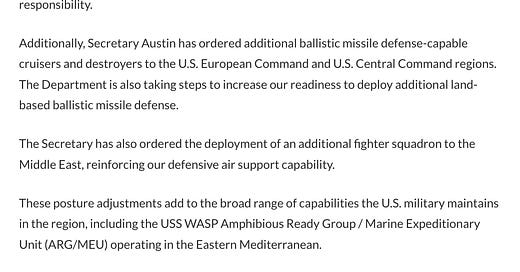The Natsec Gods of the Copybook Headings Have a Reminder
your best tool for the job is never obsolete
You can have your talking points.
You can have your theories.
You can have your wishcasting from “loyal wingman” to “1,000 ship navy,” but what you cannot have is the cold, clear reality that is placed in front of you over and over and over.
The more you ignore it, the less credibility you have and if you hold a lever of power, the more danger you put that which you were given stewardship over.
From the indispensable aircraft carrier to the indispensable nation, these are the thin reeds the world’s stability rests on.
The aircraft carrier is always an attractive target, and I’m not talking about our nation’s enemies. No. It has other opponents.
Carriers are big. They are manpower intensive. They cost unimaginable amounts of money. They drive plans, budgets, basing, and almost everything else because when you need more of something - money, manpower, or ideas - the aircraft carrier is always the big lady in a small room taking up the space you need.
Yes, she is fragile. She has always been as she is designed to give a punch, not take one.
Yes, she is vulnerable. She has always been something that is dangerous and cannot be allowed free use of the seas.
Yes, she is a drain on resources, as you get what you pay for.
In times of peace and quiet - or foolish times - our naturally maritime and aerospace power nation gets tricked into a land war in Asia or other strategic error. When this happens, the aircraft carrier can slip into the background, with her enemies nipping at her heels and offering her up as a sacrifice for the latest idea from the Good Idea Fairy - or simply to divert fewer dollars to defense, hoping that the world has moved beyond history and other childish foolishness.
There is one thing that never fails: whenever the real world rears its ugly head to throw shade on fun theories, decision-makers and those tasked with implementing policy are always looking for, and wanting more of two things; the Carrier Strike Group (CSG) and her funky little sister, the Amphibious Readiness Group (ARG).
That covers the, “cARriErs aRE oBSoleTE” trope.
What about the rest of the world that just can’t get over us?
A bit over two weeks ago word got out that the CENTCOM Commander, General Kurilla, USA warned up the chain that in the Middle East, deterrence is failing. Gen. Kurilla flew into the Middle East on Saturday for meetings across the area.
Now is not the time for virtual presences, good feelings, or comfortable theories. Iran has given every indication she will attack Israel again. Nothing can blunt her attack as well as a Carrier Strike Group, that is why it is there. Should we need to evacuate American citizens from the Levant, nothing can do that better than an ARG/MEU; that is why it is where it is.
We may want to concentrate on the Pacific, but the Middle East and Europe are jealous mistresses and will not let us go that easily. None of our allies, for decades content amongst the Lotus Eaters, can help much more than on the margins. And so, here we are again. Once again unto the breach.
Can you imagine a world where we backed away from Iran’s challenge? Have you pondered the second and third-order effects?
What would we or our allies do without the Big Stick that only an American CSG and ARG can bring to the table?
How unstable would the Middle East and Europe be without the anti-ballistic missile capabilities only the US Navy has with its Aegis destroyers and cruisers?
Again, the world is signaling that we have an under-resourced Navy. We have too few carriers and Aegis-capable warships. We need to be clear-eyed about the world as it is, not as some clever briefer sells you that it should be, and allocate our defense budgets accordingly.






Marine officer: "Maggot, you're here to defend this ship against the deadliest enemy she's ever faced".
Skyler: "Soviet commandos? Iranian terrorists?"
Marine officer: " NO MAGGOT, BUDGET CUTTERS!"
I have said in the forums that one of our major military weaknesses is that we buy to budget not budget toby whatʻs needed. At one time, we needed fifteen carriers, then twelve, now ten -- until we need them. Then we really need them. You canʻt just sign in to Amazon and buy a Ford class carrier. They take years to build.
I often hear about how expensive they are. How expensive is it to not have what you need? BTW, "An Associated Press analysis found that fraudsters potentially stole more than $280 billion in COVID-19 relief funding; another $123 billion was wasted or misspent. Combined, the loss represents 10% of the $4.2 trillion the U.S. government has so far disbursed in COVID relief aid."
USS Gerald Ford cost $13.3 billion. We could buy and man ten Ford class CVNs for what we wasted on COVID (not counting the costs of the shutdown).